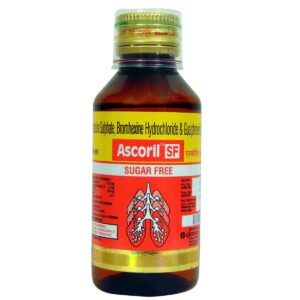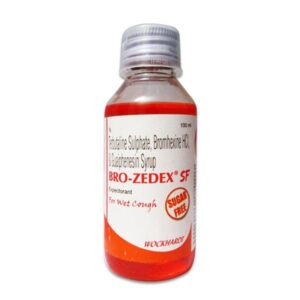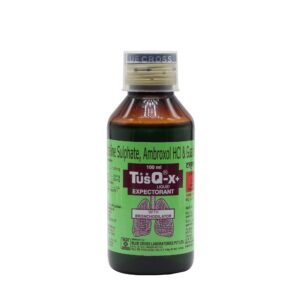BROMHEXINE + GUAIPHENESIN + TERBUTALINE
Bromhexine: Bromhexine is a medication primarily used to treat respiratory disorders associated with excessive mucus production. It is commonly prescribed for conditions such as bronchitis, chronic obstructive pulmonary disease (COPD), and asthma.
The main mechanism of action of bromhexine is through its ability to increase the production of thinner and less viscous respiratory secretions. It does this by stimulating the activity of the cells in the respiratory tract, which produce mucus. This helps in the clearance of mucus from the lungs and airways, making it easier to breathe and reducing coughing.
Bromhexine is typically taken orally in the form of tablets or syrups. The recommended dose varies depending on the age, weight, and condition of the patient. It is important to follow the prescribed dosage instructions provided by the healthcare professional or as indicated on the product label.
As with any medication, bromhexine can cause certain side effects. Common side effects include gastrointestinal complaints such as stomach upset, nausea, and diarrhea. Rarely, more serious side effects can occur, such as allergic reactions, skin rashes, or liver problems. If any unusual or severe side effects occur, it is important to seek medical attention promptly.
It is worth noting that bromhexine should not be used without a doctor’s recommendation, especially in certain situations such as pregnancy, breastfeeding, or in patients with a history of liver disorders or stomach ulcers. It is important to consult a healthcare professional to determine the appropriate usage and dosage of bromhexine for each individual case.
Guaiphenesin: Guaiphenesin is a drug commonly used for its expectorant properties. It is used to treat coughs and congestion associated with respiratory conditions such as the common cold, bronchitis, and allergies.
The mechanism of action of guaiphenesin is not fully understood. However, it is believed to work by reducing the viscosity of mucus in the airways, making it easier to cough up and clear from the lungs. By thinning and loosening the mucus, guaiphenesin helps to alleviate congestion and promote easier breathing.
Guaiphenesin is available in various formulations such as tablets, capsules, liquid syrups, and extended-release tablets. The dosage and frequency of use may vary depending on the specific product and the individual’s age and medical condition. It is important to follow the instructions provided by the healthcare professional or the information leaflet accompanying the medication.
Common side effects of guaiphenesin may include nausea, vomiting, stomach upset, dizziness, and headache. These side effects are usually mild and temporary. However, if they persist or worsen, it is advisable to consult a healthcare professional. Rarely, individuals may experience more severe side effects such as allergic reactions, hives, rash, or difficulty breathing. If any of these symptoms occur, immediate medical attention should be sought.
It is important to note that guaiphenesin may interact with other medications, so it is essential to inform the healthcare professional about any other drugs being taken. Additionally, individuals with certain medical conditions such as kidney or liver problems should exercise caution when using guaiphenesin and consult their healthcare provider before starting the medication.
Terbutaline: Terbutaline is a medication primarily used to treat symptoms of bronchospasm, such as wheezing, shortness of breath, and chest tightness, associated with conditions such as asthma, chronic obstructive pulmonary disease (COPD), and bronchitis. It belongs to a class of drugs known as beta-2 adrenergic agonists or bronchodilators.
Terbutaline works by binding to and stimulating beta-2 adrenergic receptors in the smooth muscles of the airways, causing relaxation and dilation of the bronchial passages. This leads to an improvement in airflow and relief of symptoms associated with bronchospasm.
The medication is available as an inhaler, tablet, or injection. The recommended dose and method of administration can vary depending on the form of the drug and the specific condition being treated.
For relief of acute symptoms, terbutaline inhalers are commonly used. The typical adult dose is 0.5 to 1 mg (2-4 puffs) every 4-6 hours as needed. The maximum daily dose should not exceed 8 puffs. However, it is important to follow the instructions provided by the healthcare professional or read the medication label for precise dosing information.
Side effects of terbutaline can include tremors, headache, increased heart rate (tachycardia), palpitations, nervousness, muscle cramps, dizziness, and nausea. These side effects are generally mild and temporary. In rare cases, more serious side effects such as chest pain, irregular heart rhythm, or allergic reactions may occur and require immediate medical attention.
It is important to note that terbutaline should not be used as a substitute for long-term management of asthma or COPD. It is primarily intended for acute relief of bronchospasm, and individuals should consult with a healthcare professional to develop a comprehensive treatment plan that includes appropriate long-term medications and strategies to manage their respiratory condition.



